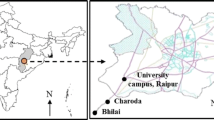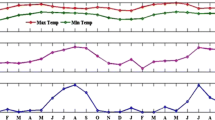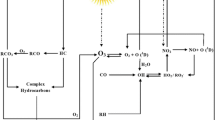Abstract
The atmospheric chemistry and health implications of pollutants are important scientific concerns in the rural atmosphere. The current study investigates the estimation of seasonal and diurnal variability of VOCs, ozone, and NOx in the rural area located in a tropical region of India during the year 2013–2014. Results showed that most of the targeted VOCs were higher in winter followed by summer and autumn. The diurnal variability of aromatic hydrocarbons showed similar pattern with different amplitudes as maxima and minima during morning (07:00–10:00 h) or evening (16:00–19:00 h) and daytime (10:00–16:00 h), respectively. The sum of aromatic VOCs are found to be in the range from 27.3 to 87.9 μg/m3. In addition to this, O3 and NOx were observed as 45.04 ± 15.19 μg/m3 and 12.41 ± 3.49 μg/m3, respectively, during the observation period. The estimated VOC/NOx ratios (ranged from 3.4 to 3.7) indicated that the selected rural area was VOC limited in terms of ozone sensitivity. The sources of the VOCs have been explained by characteristic ratios, correlation, and principal component analysis. Further, ozone-forming potential (OFP) of the targeted aromatic VOCs has been evaluated using maximum incremental reactivity which suggested toluene (benzene) contributed the largest (lowest) in the ozone formation. Exposure assessment in terms of lifetime cancer and non-cancer risks lies within the acceptable range of USEPA guidelines.







Similar content being viewed by others
References
Alghamdi MA, Khoder M, Abdelmaksoud AS, Harrison M, Hussein T (2014) Seasonal and diurnal variations of BTEX and their potential for ozone formation in the urban background atmosphere of the coastal city Jeddah, Saudi Arabia. Air Qual Atmos Health 7:467–480
Avery RJ (2006) Reactivity-based VOC control for solvent products: more efficient ozone reduction strategies. Environ Sci Technol 40:4845–4850
Baudice A, Gros V, Sauvage S, Locoge N, Sanchez O, Kalogridis C (2016) Seasonal variability and source apportionment of volatile organic compounds (VOCs) in the Paris megacity (France). Atmos Chem Phys Diss 185:1–51
Bon DM, Ulbrich IM, De Gouw JA, Warneke C, Kuster WC, Alexander ML, Baker A (2011) Measurements of volatile organic compounds at a suburban ground site (T1) in Mexico City during the MILAGRO 2006 campaign: measurement comparison , emission ratios , and source attribution. Atmos Chem Phys 11:2399–2421
Cai CJ, Geng FH, Tie XX, Yu Q, Li P, Zhou GQ (2010) Characteristics of ambient volatile organic compounds (VOCs) measured in shanghai. China, Sensors 10:7843–7862
Carter WPL (1994) Development of ozone reactivity scales for volatile organic compounds. J Air Waste Manage Assoc 44:881–899
Cerón-Bretón JG, Cerón-Bretón RM, Kahl JDW, Ramírez-Lara E, Guarnaccia C, Aguilar-Ucán CA, Montalvo-Romero C, Anguebes-Franseschi F, López-Chuken U (2015) Diurnal and seasonal variation of BTEX in the air of Monterrey, Mexico: preliminary study of sources and photochemical ozone pollution. Air Qual Atmos Health 8:469–482
Chang CT, Chen BY (2008) Toxicity assessment of volatile organic compounds and polycyclic aromatic hydrocarbons in motorcycle exhaust. J Hazard Mat 153:1262–1269
Choi SW, Park SW, Lee CS, Kim HJ, Bae S, Inyang HI (2009) Patterns of VOC and BTEX concentration in ambient air around industrial sources in Daegu, Korea. J Environ Sci Health Part-A 44:99–107
de Blas M, Navazo M, Alonso L, Durana N, Iza J (2013) Trichloroethylene, tetrachloroethylene and carbon tetrachloride in an urban atmosphere: mixing ratios and temporal patterns. Intl J Environ Anal Chem 93(2):228–244
Debaje SB, Kakade AD (2009) Surface ozone variability over western Maharashtra. India J Hazard Mater 161:686–700
Demir S, Saral A, Ertürk F (2012) Effect of diurnal changes in VOC source strengths on performances of receptor models. Environ Sci Pollut Res 19:1503–1514
Du Z, Mo J, Zhang Y (2014) Risk assessment of population inhalation exposure to volatile organic compounds and carbonyls in urban China. Environ Int 73:33–45
Duan J, Tan J, Yang L, Wu S, Hao J (2008) Concentration , sources and ozone formation potential of volatile organic compounds (VOCs) during ozone episode in Beijing. Atmos Res 88:25–35
Duenas C, Fernandez MC, Canete S, Carretero J, Liger E (2004) Analyses of ozone in urban and rural sites in Malaga (Spain). Chemosphere 56:631–639
Dumanoglu Y, Kara M, Altiok H, Odabas M, Elbir T (2014) Spatial and seasonal variation and source apportionment of volatile organic compounds (VOCs) in a heavily industrialized region. Atmos Environ 98:168–178
Filella IÃ, Peñuelas J (2006) Daily, weekly and seasonal time courses of VOC concentrations in a semi-urban area near Barcelona. Atmos Environ 40:7752–7769
Hallquist M, Wenger JC, Baltensperger U, Rudich Y, Simpson D, Claeys M, Dommen J (2009) The formation , properties and impact of secondary organic aerosol: current and emerging issues. Atmos Chem Phys 9:5155–5236
Hassan IA, Basahi JM, Iqbal MI, Tutki MH (2013) Spatial distribution and temporal variation in ambient ozone and its associated NOx in the atmosphere of Jeddah City, Saudi Arabia. Aeros Air Qual Res 13:1712–1722
Ho KF, Lee SC, Guo H, Tsai WY (2004) Seasonal and diurnal variations of volatile organic compounds (VOCs) in the atmosphere of Hong Kong. Sci Total Environ 322:155–166
Huang Y, Sai S, Ho H, Ho KF, Lee SC, Yu JZ, Louie PKK (2011) Characteristics and health impacts of VOCs and carbonyls associated with residential cooking activities in Hong Kong. J Hazard Mat 186:344–351
IARC (2006) Monographs on the evaluation of carcinogenic risks to humans. Complete list of agents evaluated and their classification
Kang DW, Aneja VP, Mathur R, Ray JD (2004) Observed and modeled VOC chemistry under high VOC/NOx conditions in the Southeast United States national parks. Atmos Environ 38:4969–4974
Kansal A (2009) Sources and reactivity of NMHCs and VOCs in the atmosphere: a review. J Hazard Mat 166:17–26
Kim KH, Shon ZH, Kim MY, Sunwoo Y, Jeon EC, Hong JH (2008) Major aromatic VOC in the ambient air in the proximity of an urban landfill facility. J Hazard Mater 150:754–764
Kos G, Kanthasami V, Adechina N, Ariya PA (2014) Volatile organic compounds in Arctic snow: concentrations and implications for atmospheric processes. Environ Sci Proc Imp 16:2592–2603
Kumar A, Singh BP, Punia M, Singh D, Kumar K, Jain VK (2013) Assessment of indoor air concentrations of VOCs and their associated health risks in the library of Jawaharlal Nehru University, New Delhi. Environ Sci Pollu Res 21:2240–2248
Kumar A, Singh BP, Punia M, Singh D, Kumar K, Jain VK (2014a) Determination of volatile organic compounds and associated health risk assessment in residential homes and hostels within an academic institute, New Delhi. Indoor Air 24:474–483
Kumar A, Singh D, Singh BP, Singh M, Kumar K, Jain VK (2014b) Spatial and temporal variability of surface ozone and nitrogen oxides in urban and rural ambient air of Delhi-NCR, India. Air Qual Atmos Health 8:391–399
Kuo CP, Liao HT, Chou CCK, Wu CF (2014) Source apportionment of particulate matter and selected volatile organic compounds with multiple time resolution data. Sci Total Environ 472:880–887
Lai C, Chuang K, Chang J (2013) Source apportionment of volatile organic compounds at an international airport. Aero Air Qual Res 13:689–698
Li L, Xie S, Zeng L, Wu R, Li J (2015) Characteristics of volatile organic compounds and their role in ground-level ozone formation in the Beijing-Tianjin-Hebei region, China. Atmos Environ 113:247–254
Liu Y, Shao M, Lu S, Chang C, Wang J, Chen G (2008) Volatile organic compound (VOC) measurements in the Pearl River Delta (PRD) region, China. Atmos Chem Phys 8:1531–1545
Lü H, Cai Q, Wen S, Chi Y, Guo S, Sheng G, Fu J, Antizar-Ladislao B, Lü H, Cai Q, Wen S (2009) Carbonyl compounds in the ambient air of hazy days and clear days in Guangzhou, China. Atmos Res 94:363–372
Miller L, Xu X, Mannion AG, Brook J, Wheeler A (2012) Multi-season, multi-year concentrations and correlations amongst the BTEX group of VOCs in an urbanized industrial city. Atmos Environ 61:305–315
Monod A, Sive BC, Avino P, Chen T, Blake DR, Rowland FS (2001) Monoaromatic compounds in ambient air of various cities: a focus on correlations between the xylenes and ethylbenzene. Atmos Environ 35:135–149
Naja M, Lal S (2002) Surface ozone and precursor gases at Gadanki (13.5°N, 79.2°E), a tropical rural site in India. J Geophys Res 107:4197
Nguyen HT, Kim KH, Kim MY (2009) Volatile organic compounds at an urban monitoring station in Korea. J Hazard Mat 161:163–174
Niu Z, Zhang H, Xu Y, Liao X, Xu L, Chen J (2012) Pollution characteristics of volatile organic compounds in the atmosphere of Haicang District in Xiamen City, Southeast China. J Environ Monit 14:1145–1152
Oiamo TH, Johnson M, Tang K, Luginaah IN (2015) Assessing traffic and industrial contributions to ambient nitrogen dioxide and volatile organic compounds in a low pollution urban environment. Sci Total Environ 529:149–157
Olumayede EG, Okuo JM (2012) Distribution, temporal and diurnal behaviors of total volatile organic compounds over the urban atmosphere of southwestern Nigeria. J Environ Sc Eng A 1:785–796
Pagans E, Font X, S’anchez A (2006) Emission of volatile organic compounds from composting of different solid wastes: abatement by biofiltration. J Hazard Mat 131:179–186
Parra MA, González L, Elustondo D, Garrigó J, Bermejo R, Santamaría JM (2006) Spatial and temporal trends of volatile organic compounds (VOC) in a rural area of northern Spain. Sci Total Environ 370:157–167
Prinn R, Cunnold D, Rasmussen R, Simmonds P, Alyea F, Crawford A, Fraser P, Rosen R (1987) Atmospheric trends in methylchloroform and the global average for the hydroxyl radical. Science 238:945–950
Ramanathan V, Ramana MV, Roberts G, Kim D, Corrigan C, Chung C, Winker D (2007) Warming trends in Asia amplified by brown cloud solar absorption. Nature 448:575–578
Ramírez N, Cuadras A, Rovira E, Borrull FR, Marcé M (2012) Chronic risk assessment of exposure to volatile organic compounds in the atmosphere near the largest Mediterranean industrial site. Environ Int 39:200–209
Ran L, Zhao C, Geng F, Tie X, Tang X, Peng L, Zhou G, Yu Q, Xu J, Guenther A (2009) Ozone photochemical production in urban Shanghai , China: analysis based on ground level observations. J Geo Res 114:1–14
Ras MR, Marcé RM, Borrull F (2009) Characterization of ozone precursor volatile organic compounds in urban atmospheres and around the petrochemical industry in the Tarragona region. Sci Total Environ 407:4312–4319
Reddy BSK, Kumar KR, Balakrishnaiah G, Gopal KR, Reddy RR, Sivakumar V, Lingaswamy AP, Arafath SM, Umadevi K, Kumari SP, Ahammed YN, Lal S (2012) Analysis of diurnal and seasonal behavior of surface ozone and its precursors (NOx) at a semi-arid rural site in southern India. Aero Air Qual Res 12:1081–1094
Sánchez NS, Alarcón ST, Santonja RT, Pórcel JL (2014) New device for time-averaged measurement of volatile organic compounds (VOCs). Sci Total Environ 485–486:720–725
Saral A, Demir S, Yıldız S (2009) Assessment of odorous VOCs released from a main MSW landfill site in Istanbul-Turkey via a modelling approach. J Hazard Mat 168:338–345
Sarkar C, Chatterjee A, Majumdar D, Ghosh SK, Srivastava A, Raha S (2014) Volatile organic compounds over eastern Himalaya, India: temporal variation and source characterization using positive matrix factorization. Atmos Chem Phys Discuss 14:32133–32175
Sauvage S, Plaisance H, Locoge N, Wroblewski A, Coddeville P, Galloo JC (2009) Long term measurement and source apportionment of non-methane hydrocarbons in three French rural areas. Atmos Environ 43:2430–2441
Singh D, Kumar A, Singh BP, Anandam K, Singh M, Mina U, Kumar K, Jain VK (2015) Spatial and temporal variability of VOCs and its source estimation during rush/non-rush hours in ambient air of Delhi, India. Air Qual Atmos Health 9:483–493
Singh D, Kumar A, Kumar K, Singh B, Mina U, Singh BB, Jain VK (2016) Statistical modeling of O3 , NOx , CO , PM2.5, VOCs and noise levels in commercial complex and associated health risk assessment in an academic institution. Sci Total Environ 572:586–594
Strandberg B, Rynell KB, Sallsten G (2014) Evaluation of three types of passive samplers for measuring 1,3-butadiene and benzene at workplaces. Environ Sci Proc Imp 16:1006–1014
Tan JH, Guo SJ, Ma YL, Yang FM, He KB, Yu YC, Wang JW, Shi ZB, Chen GC (2012) Non-methane hydrocarbons and their ozone formation potentials in Foshan. China, Aero Air Qual Res 12:387–398
Tang JH, Chan LY, Chan CY, Lia YS, Chang CC, Liu SC, Wu D, Li YD (2007) Characteristics and diurnal variations of NMHCs at urban, suburban, and rural sites in the Pearl River Delta and a remote site in South China. Atmos Environ 41:8620–8632
Tang JH, Chan LY, Chang CC, Liu S, Li YS (2009) Characteristics and sources of non-methane hydrocarbons in background atmosphere of eastern, southwestern and southern China. J Geophy Res 114:D03304
Tiwari V, Hanai Y, Masunaga S (2010) Ambient levels of volatile organic compounds in the vicinity of petrochemical industrial area of Yokohama, Japan. Air Qual Atmos Health 3:65–75
Toro AR, Seguel RJ, Raul GEMS, Manuel ALG (2015) Ozone, nitrogen oxides, and volatile organic compounds in a central zone of Chile. Air Qual Atmos Health 8:545–557
USEPA (1997) Air risk assessment work plan. Air and Radiation Division, Tristate, EPA, Washington
United States Environmental Protection Agency (USEPA) (1998) Integrated risk information system, www.epa.gov. US Environmental Protection Agency, Washington, DC
Wang T, Wong CH, Cheung TF, Blake DR, Arimoto R, Baumann K, Tang J, Ding GA, Yu XM, Li YS, Streets DG, Simpson IJ (2004) Relationships of trace gases and aerosols and the emission characteristics at Linan, a rural site in eastern China, during spring 2001. J Geophys Res 109:D19S05
Wang Y, Hu B, Tang G, Ji D, Zhang H, Bai J, Wang X, Wang Y (2013) Characteristics of ozone and its precursors in northern China: a comparative study of three sites. Atmos Res 132–133:450–459
Yan Y, Peng L, Li R, Li Y, Li L, Bai H (2017) Concentration, ozone formation potential and source analysis of volatile organic compounds (VOCs) in a thermal power station centralized area: a study in Shuozhou. China, Environ Poll 223:295–304
Yang M, Wang Y, Chen J, Li H, Li Y (2016) Aromatic hydrocarbons and halocarbons at a mountaintop in southern China. Aerosol Air Qual Res 16:478–491
Zhang Y, Mu Y, Liu J, Mellouki A (2012) Levels, sources and health risks of carbonyls and BTEX in the ambient air of Beijing, China. J Environ Sci 24:124–130
Zhang Y, Wang X, Barlett SIJ, Blake DR, Fu X, Zhang Z, Ding X (2013) Source attributions of hazardous aromatic hydrocarbons in urban, suburban and rural areas in the Pearl River Delta (PRD) region. J Hazard Mater 250–251:403–411
Zhou J, You Y, Bai Z, Hu Y, Zhang J, Zhang N (2011) Environment health risk assessment of personal inhalation exposure to volatile organic compounds in Tianjin, China. Sci Total Environ 409:452–459
Zhu Y, Yang L, Chen J, Wang X, Xue L, Shao M, Lu S, Wang W (2016) Characteristics of ambient volatile organic compounds and the influence of biomass burning at a rural site in northern China during summer 2013. Atmos Environ 124:156–165
Acknowledgements
The study is supported by Research Grant (Senior Research Fellowship) from Council for Scientific and Industrial Research (CSIR) and Department of Science and Technology (DST) New Delhi, India.
Author information
Authors and Affiliations
Corresponding author
Rights and permissions
About this article
Cite this article
Kumar, A., Singh, D., Anandam, K. et al. Dynamic interaction of trace gases (VOCs, ozone, and NOx) in the rural atmosphere of sub-tropical India. Air Qual Atmos Health 10, 885–896 (2017). https://doi.org/10.1007/s11869-017-0478-8
Received:
Accepted:
Published:
Issue Date:
DOI: https://doi.org/10.1007/s11869-017-0478-8




